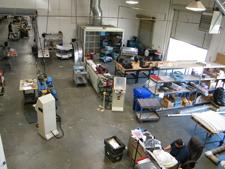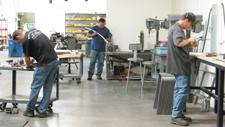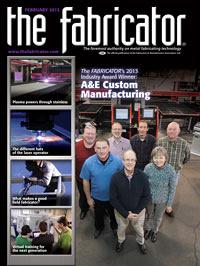Senior Editor
- FMA
- The Fabricator
- FABTECH
- Canadian Metalworking
Categories
- Additive Manufacturing
- Aluminum Welding
- Arc Welding
- Assembly and Joining
- Automation and Robotics
- Bending and Forming
- Consumables
- Cutting and Weld Prep
- Electric Vehicles
- En Español
- Finishing
- Hydroforming
- Laser Cutting
- Laser Welding
- Machining
- Manufacturing Software
- Materials Handling
- Metals/Materials
- Oxyfuel Cutting
- Plasma Cutting
- Power Tools
- Punching and Other Holemaking
- Roll Forming
- Safety
- Sawing
- Shearing
- Shop Management
- Testing and Measuring
- Tube and Pipe Fabrication
- Tube and Pipe Production
- Waterjet Cutting
Industry Directory
Webcasts
Podcasts
FAB 40
Advertise
Subscribe
Account Login
Search
Tube bending, the next generation
Modern tube bending meets old-school business
- By Tim Heston
- February 15, 2013
- Article
- Shop Management

Tube Bending Inc., a Southern California job shop, recently doubled its plant size to 10,000 square feet.
A small Southern California tube shop has roots going back to the Gemini and Apollo days, when technicians manually bent small tubes designed for astronaut life support backpacks. The shop’s tube bending technicians in the 1950s and 1960s played a critical role. If those tubes didn’t function properly, Neil Armstrong wouldn’t have survived on the moon.
Of course, back then the job shop was part of an entirely different and larger organization that offered various facets of metal manufacturing, including sheet metal fabrication, machining, and casting. Then in the 1980s and 1990s, the shop’s previous owner began his gradual exit from the business. He sold off most divisions to other companies but kept the tube bending operation.
A little more than two decades ago the owner moved the tube business—Tube Bending Inc. (TBI)—from Santa Fe Springs, in the Los Angeles metro area, to Apple Valley, a small community north of San Bernardino. When Bryan Christoffersen expressed interest in buying the business in 2005, the shop employed just four people.
Christoffersen spent years as an engineer at another firm that made refrigeration equipment for semiconductor production, which happened to use TBI as a principal tube bending provider. The previous owner wanted to retire, and seeing an opportunity, Christoffersen bought the business.
TBI specializes in small-diameter tube bending. Using all-electric and hydraulic rotary draw machines, as well as an orbital bending machine for making coil, the shop forms tube between 0.062 and 2 inches in diameter. “Our mainstay is 0.25 to 1.5 inch,” Christoffersen said, adding that stainless and aluminum make up the bulk of TBI’s work, though the shop does bend plenty of INCONEL® alloy and other metals common in aerospace and defense.
On the surface, the business looks far different today than it did only eight years ago. The shop employs a dozen people and recently underwent a building expansion for a total of 10,000 square feet, doubling available floor space. The company broadened its in-house capabilities to include helium-leak detection, and purchased a CNC vertical machining center, complementing TBI’s conventional milling and turning capabilities.
The company now machines 70 percent of its tooling in-house, and it can create some complex tools, such as those needed for compound bending or tangent-to-tangent bends that require special inserts, because the tube lacks a straight section between bends. They regularly tackle projects that require technicians to bend tube at a radius that’s one times its diameter.
TBI also employs a 3-D tube inspection system. To operate the coordinate measuring machine, a technician places an inspection arm in certain areas above the material surface. The system takes this information and gives a mathematical comparison between the product and the computer model.
When Christoffersen walked onto the shop floor in 2005, he found an environment full of blueprints and board drawings—no computer-aided design. Some communicated with TBI via e-mail, but many still used a fax machine. Some sent engineering drawings by U.S. mail.
When Christoffersen took over, he found customer drawings that the shop had been using for decades. “For certain customers, we were making the same parts we made for them 30 years ago. We have blueprints that were drawn before I was born,” he said.

TBI employs this coordinate measuring system, part of the cadre of new technology acquired since the current owner took over in 2005.
The engineer turned tube shop entrepreneur didn’t tell the typical “that was then, this is now” story. He didn’t walk into the business with a formal intention to modernize things. After all, the shop had been responsive for decades. The company had longtime, happy customers. The blueprints may have been old, but that didn’t mean they weren’t good anymore.
The new owner chose to adopt 3-D CAD “because that was the way I knew how to do it,” he said. “I can’t say there was a strategic plan to migrate to modern technology. It was a gradual transition. We wanted to grow the business, and we wanted to keep existing customers happy.”
So how does the shop compare with its pre-2005 state? Is it like night and day, considering all the new technology? When answering, Christoffersen was circumspect. Modern technology has allowed the shop to grow and thrive. Its inspection technology and quality certifications, such as AS9100, have opened doors to new customers. Still, then as now, good people really make the difference.
The old way of drawing by hand and operating manual equipment had worked for decades. It had helped bend tubular components that kept astronauts alive on the moon. Call it old-school, but that school was pretty good.
Images provided by Tube Bending Inc., 13356 Manhasset Road, Apple Valley, CA 92308, 760-948-4220, www.tubebendinginc.com.
About the Author

Tim Heston
2135 Point Blvd
Elgin, IL 60123
815-381-1314
Tim Heston, The Fabricator's senior editor, has covered the metal fabrication industry since 1998, starting his career at the American Welding Society's Welding Journal. Since then he has covered the full range of metal fabrication processes, from stamping, bending, and cutting to grinding and polishing. He joined The Fabricator's staff in October 2007.
subscribe now

The Fabricator is North America's leading magazine for the metal forming and fabricating industry. The magazine delivers the news, technical articles, and case histories that enable fabricators to do their jobs more efficiently. The Fabricator has served the industry since 1970.
start your free subscription- Stay connected from anywhere

Easily access valuable industry resources now with full access to the digital edition of The Fabricator.

Easily access valuable industry resources now with full access to the digital edition of The Welder.

Easily access valuable industry resources now with full access to the digital edition of The Tube and Pipe Journal.
- Podcasting
- Podcast:
- The Fabricator Podcast
- Published:
- 04/16/2024
- Running Time:
- 63:29
In this episode of The Fabricator Podcast, Caleb Chamberlain, co-founder and CEO of OSH Cut, discusses his company’s...
- Trending Articles
Capturing, recording equipment inspection data for FMEA

Tips for creating sheet metal tubes with perforations

Are two heads better than one in fiber laser cutting?

Supporting the metal fabricating industry through FMA

Hypertherm Associates implements Rapyuta Robotics AMRs in warehouse

- Industry Events
16th Annual Safety Conference
- April 30 - May 1, 2024
- Elgin,
Pipe and Tube Conference
- May 21 - 22, 2024
- Omaha, NE
World-Class Roll Forming Workshop
- June 5 - 6, 2024
- Louisville, KY
Advanced Laser Application Workshop
- June 25 - 27, 2024
- Novi, MI



























